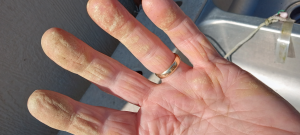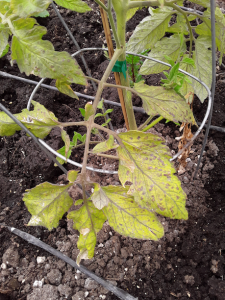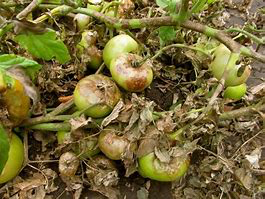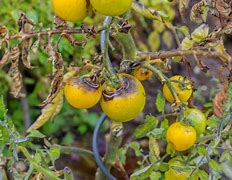The Problem
- Blight is an infestation of microorganisms that, if not dealt with quickly, can be devastating (think “Ireland in the 1840s.”)
- The spores of blight are extremely small -- about half the size of household dust -- and spread very quickly to other plants and then across the entire garden.


- Tomatoes and potatoes are the two crops most severely affected, but peppers and eggplant are also highly susceptible. Blight occurs in two different forms:
• Early blight, caused by a genus of fungi, Alternaria.
• Late blight, caused by the fungus-like Phytophthora infestans (technically, a “water mold.”) - In either case, the spores of the pathogens can stay active in the soil for several years so the normal control practice of crop rotation doesn’t solve the problem.
Identification
- Early blight symptoms usually begin after the first fruits appear on tomato plants, starting with a few small, brown lesions on the bottom leaves which are in contact with the ground.


- Late blight can actually affect tomato plants at any point in the growing season and at any stage of growth. Symptoms appears at the edge of tomato leaves, with dark, damaged plant tissue that spreads through the leaves toward the stem. White mildew may grow on the lower leaf surface of the affected area. This type of blight progresses rapidly through plants in humid conditions, and if left untreated, can spread to fruits.


- It’s not all that important that you distinguish between early or late blight. In fact, it’s not really necessary to determine whether your plants are infested by blight or wilt (Verticillium or Fusarium) since the effects and the controls are pretty much the same.


Controls
- The most effective control for blight is to prevent it from occurring in the first place.
- That begins with planting starts or seeds of a variety that is resistant to the specific pathogen. Specific codes are used to designate plants or seeds that are resistant to various pests or diseases.
- Tomato varieties that are resistant to blight can be identified by such as the letters: A = Alternaria, EB = Early Blight, LB = Late Blight. There may be additional codes such as HR for High Resistance or IR for Intermediate Resistance.
- Since fungal diseases strike plants when conditions such as moisture and temperature encourage their development and spread simple cultural practices can help you limit their effect:
- Cover the soil under the plants with mulch, or dried leaves.
- Water at the base of each plant, using drip irrigation, a soaker hose, or careful hand watering.
- Increase airflow by staking or trellising, removing weeds, and spacing plants adequately apart
- Pruning the bottom leaves can also prevent early blight spores from splashing up from the soil onto leaves.
- While it’s claimed that baking soda has fungicidal properties that can stop or reduce the spread of early and late tomato blight, experience hasn’t been encouraging.
- Once blight is positively identified, act quickly to prevent it from spreading.
- Remove all affected leaves and burn them or place them in the garbage.
- Disinfect all tools. Dip pruners in alcohol, bleach or other sanitizer.
- Be aware that blight spores are extremely small -- about half the size of household dust. Clothing worn while removing infested plants will help spread blight to other plants.
- Note the green residue on a glove that was worn while pruning infested tomato plants. Those are blight spores!!


Do Not Compost Diseased Plant Material!
- Internet sites: http://www.tomatodirt.com/blight-resistant-tomato-varieties.html
